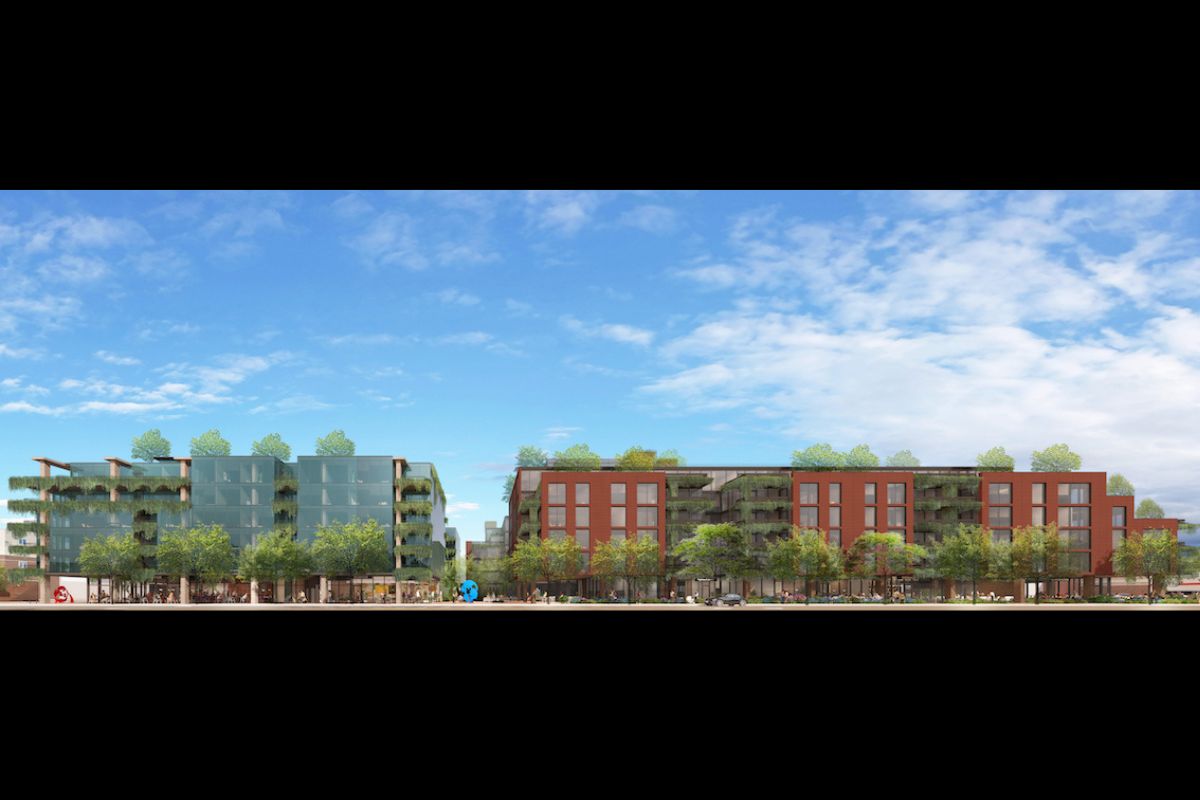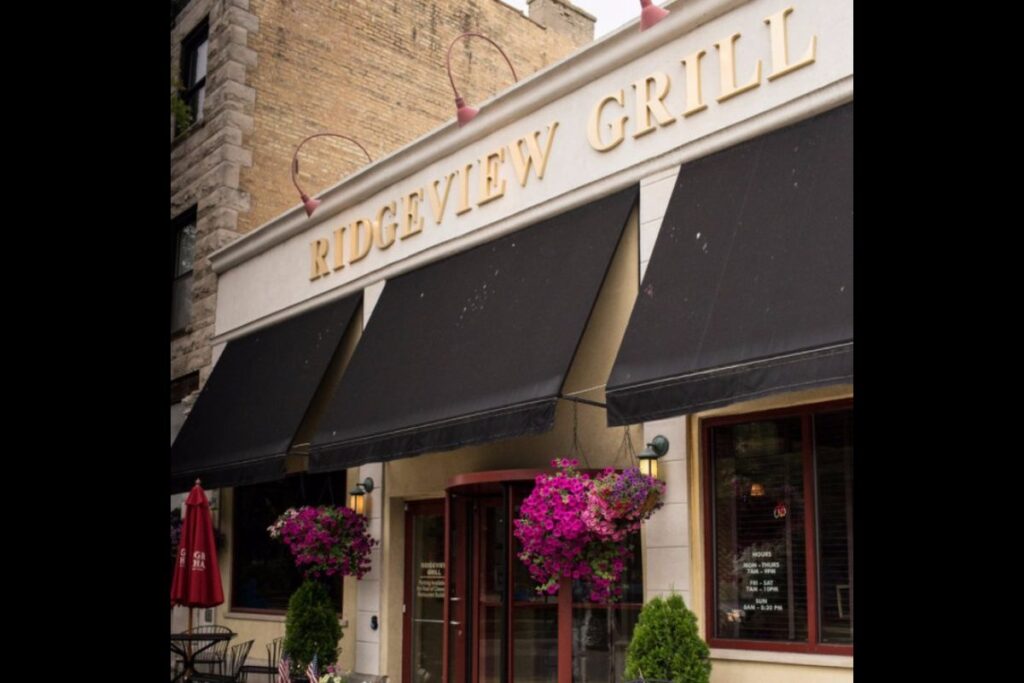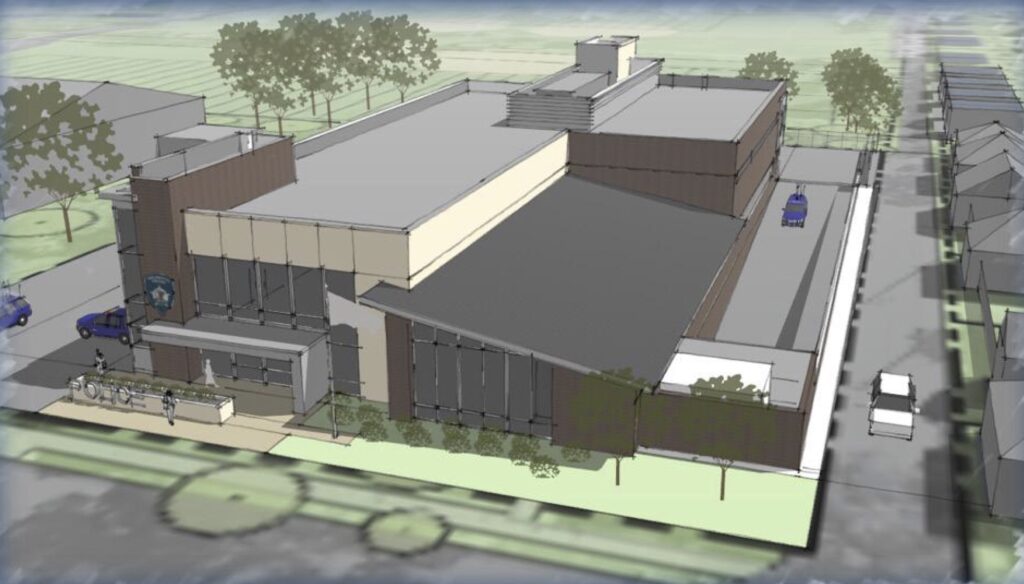
Wilmette trustees evaluate Optima Lumina during meeting of 4-plus hours
There may be light at the end of the tunnel for a prominent real estate developer’s plans to reimagine a signature but long-vacant Wilmette property near the village’s downtown.
But if the first review from Wilmette’s Village Board is any indication, Optima still has hurdles to clear.
Representatives from the development firm appeared in front of Wilmette officials on Tuesday, Sept. 24, for the sixth public review of Optima Lumina, a redevelopment proposal for a seven-story mixed use building at the former Imperial Motors site on Green Bay Road.
Trustees cast no formal vote during the more-than-four-hour session that included a detailed presentation from Optima officials, significant questioning and discussion by trustees, and just under a dozen public comments.
As previously reported by The Record, the firm’s newly proposed project, Optima Lumina, is directly north of Optima’s existing six-story, 100-unit Verdana complex at 1210 Central Ave. that was approved by village officials in February of 2020 and subsequently completed in 2023.
Current plans call for Optima Lumina to include one-, two- and three-bedroom condominiums and 5,718 square feet of commercial and retail space, according to project plans submitted to the village.
In total, Optima is proposing 128 condominium units at the site on 721-739 Green Bay Road.
The discussion on Tuesday was the first of multiple — though it is unclear how many — the Village Board will conduct on the development. Trustees offered feedback urging Optima to reconsider aspects of the building’s design and to add detail to its plans for its public plaza; however, they also expressed optimism about the potential of the project.
Village President Senta Plunkett said the next session is scheduled for Oct. 22, when trustees could take a vote, if they choose.
The road to Village Board
Wilmette’s Appearance Review and Plan commissions each conducted multiple public reviews of the project prior to the proposal’s appearance before trustees on Tuesday night.
Wilmette’s Village Board of Trustees initially requested that the Appearance Review Commission first hear Optima’s proposal, asking commissioners to offer feedback on whether and how the proposed design works within the context of downtown Wilmette, The Record reported.
In late August, the proposal made its way in front of the Plan Commission for a second time, when it received a unanimous 6-0 vote recommending approval of the project.
Following the first plan commission meeting, Optima presented a series of changes, including a new layout for the planned public plaza, widening an existing alleyway and creating an overflow loading lane to address traffic concerns as well as additional aesthetics improvements.
Previously, also detailed by The Record, updates to the project throughout its different versions have also included a redesign of the exterior facade, a larger separation of the company’s adjacent Verdana building and the new proposed building, updates to the ground floor space and other tweaks.
The version of the project that Wilmette trustees reviewed Sept. 24 is the eighth iteration that Optima officials have presented. Optima representatives feel the company’s latest pitch responds to the concerns brought forward during the review process thus far.
“We believe that the evolution of the design reflects the ultimate successful collaboration between a vertically integrated architect and developer and a village,” said David Hovey Jr., president of Optima. “We believe that, if approved, Optima Lumina will be recognized and loved by Wilmette residents as well as architecture enthusiasts of the past and present.”
The pitch
Hovey Jr. recapped the project’s main elements to trustees during his presentation on Tuesday. As part of that he offered a projection on the economic impact the development could bring to the village if it moves forward as well as details on the affordable housing plan associated with the development.
According to Hovey Jr., the 10-year fiscal impact of Optima Lumina on Wilmette could be more than $12 million.
Hovey Jr. also added that the project will create more than 225 direct, indirect and induced jobs each year during the two-year construction process. Nearly 320 jobs will be generated by ongoing operations of the project, Hovey Jr. said.
Optima officials are projecting that total wages generated by the construction of Lumina will reach $34 million while the overall economic output created by the project will exceed $74 million.
Affordable housing
Regarding affordable housing, Optima is partnering with Community Partners for Affordable Housing, a suburban nonprofit housing provider, to purchase a combination of single-family homes, rental units, and condo and townhomes to sell and rent as affordable housing, per Hovey Jr.
As part of its proposal, according to plans submitted to the village, Optima will contribute $3.8 million to Wilmette to allocate toward affordable housing “with no strings,” Hovey Jr. said, giving Wilmette’s housing commission more options with the funding, he added.
The cash contribution would be more than double what Optima provided Wilmette in affordable housing dollars via their previous project, Optima Verdana. The $1.6 million previous payment, made in 2021, reportedly funded 14 affordable housing units in the community.
Feedback
Trustees grouped their questions surrounding the proposal into several specific categories that included building design, materials and aesthetics, the commercial space included in the project, the community plaza, traffic/parking, pedestrian crossings, sustainability and more.
The board devoted significant time early in its review to focus on the building’s design and the materials that Optima is proposing to utilize. The firm’s use of terracotta again came into question.
In response to questions from the board regarding building materials, including an inquiry into whether Optima would consider using brick instead, Hovey Jr. defended the proposed use of terracotta.
“We believe that going to brick is a building system of the past and we believe that this site deserves to look toward the future — to have a unique building with a building solution here that we’ve never done before,” he said. “This isn’t part of the Optima kit of parts that people have made comments on. This is a completely different looking building than we’ve done before. We want this building to be special and unique.”
Trustee Gina Kennedy, who voiced concern over the building’s exterior design, stressed the importance she believes comes with considering this project.
“If we pass something like a tree ordinance and it doesn’t work out for us, we can change it. If we approve this building and people don’t like it, we can’t do anything,” she said. “So it’s absolutely critical that we get it right now because there is not going to be another day where we can fix things.”
Near the end of the meeting as trustees provided their final comments, Trustee Stephen Leonard said he thinks “there is still work to be done on the design.”
“I think that there is an opportunity for us to create something very exciting here that just doesn’t pass the test but actually aces the test because this is our … big project here,” Leonard said, noting that he is particularly hoping for a reevaluation of the first floor and the expression of materials so that “we can all get as excited about the design as we are about the other aspects of this project.”
In addition to highlighting concerns with the commercial space on the building’s first floor, the trustees also urged Optima to provide more clarity on the public plaza space.
Village President Senta Plunkett said that “she would like to see a better vision for the plaza.”
“I would like to know how the plaza is going to be activated and maybe to see a plan from a landscape architect here,” Plunkett said, adding that she “thinks the fountain underneath the overhang is a little awkward.
“I would like there to be a focal point in the plaza and I would like a plan that is great for the experience of both people who are in the plaza as well as people who are viewing this from a distance. I think you have an opportunity to make this very special. There are not a lot of public plazas in Wilmette and this would really be a focal point. I would love to see more attention to detail.”
Trustee Kathy Dodd shared similar sentiments, saying that the board needs to see a more fleshed out plan for the plaza space while adding that she would like to see a focal point added to the plaza that could attract families there as well.
Eleven locals offered testimony during the meeting. Contrary to previous meetings, a majority of speakers who addressed the board detailed their support for the project. But several commenters did also share their opposition.
In Optima’s closing remarks to both residents and the board, Hovey Jr. reaffirmed the company’s strong feelings about its proposal.
“We love the project,” he said. “We love the way it’s worked out. We love the fact that we’ve been able to collaborate with people. We love that Wilmette is so passionate about the design and is so passionate about this particular project and that is something that is really special about Wilmette and Wilmette citizens — that they are so passionate about their village center. But we couldn’t be more excited about the design.”
The Record is a nonprofit, nonpartisan community newsroom that relies on reader support to fuel its independent local journalism.
Become a member of The Record to fund responsible news coverage for your community.
Already a member? You can make a tax-deductible donation at any time.

Martin Carlino
Martin Carlino is a co-founder and the senior editor who assigns and edits The Record stories, while also bylining articles every week. Martin is an experienced and award-winning education reporter who was the editor of The Northbrook Tower.


